
UAV-1002560-001
Rev E
VTU-20
User and Installation Guide

UAV-1002560-001 2
Rev E
© 2019 - 2022 uAvionix Corporation. All rights reserved.
uAvionix Corporation
300 Pine Needle Lane.
Bigfork, MT 59911
http://www.uavionix.com
support@uavionix.com
Except as expressly provided herein, no part of this guide may be
reproduced, transmitted, disseminated, downloaded or stored in any
storage medium, for any purpose without the express written permission of
uAvionix. uAvionix grants permissions to download a single copy of this
guide onto an electronic storage medium to be viewed for personal use,
provided that the complete text of this copyright notice is retained.
Unauthorized commercial distribution of this manual or any revision hereto
is strictly prohibited.
uAvionix® is a registered trademark of uAvionix Corporation, and may not
be used without express permission of uAvionix.
VTU-20 is a trademark of uAvionix Corporation and may not be used
without express permission of uAvionix.

UAV-1002560-001 3
Rev E
1 Revision History
Revision
Date
Comments
A
1/7/2019
Initial release
B
3/4/2019
Updated self-test LED description and mounting
information
Update configuration instructions
C
3/14/2019
Add part numbers
Updated wiring harness information
Updated installation text and screenshots
D
12/2/2019
Updated product diagrams
Included documentation for optional VTU cap
E
2/24/2022
Update part numbers, installation and grounding
guidance

UAV-1002560-001 4
Rev E
2 Warnings / Disclaimers
All device operational procedures must be learned when not in motion.
uAvionix is not liable for damages arising from the use or misuse of this
product.
This equipment is classified by the United States Department of
Commerce's Bureau of Industry and Security (BIS) as Export Control
Classification Number (ECCN) 7A994.
These items are controlled by the U.S. Government and authorized for
export only to the country of ultimate destination for use by the ultimate
consignee or end-user(s) herein identified. They may not be resold,
transferred, or otherwise disposed of, to any other country or to any person
other than the authorized ultimate consignee or end-user(s), either in their
original form or after being incorporated into other items, without first
obtaining approval from the U.S. government or as otherwise authorized by
U.S. law and regulations.

UAV-1002560-001 5
Rev E
3 Limited Warranty
uAvionix products are warranted to be free from defects in material and
workmanship for two years from the installation in the vehicle. For the
duration of the warranty period, uAvionix, at its sole option, will repair or
replace any product which fails under normal use. Such repairs or
replacement will be made at no charge to the customer for parts or labor,
provided that the customer shall be responsible for any transportation cost.
Restrictions: This warranty does not apply to cosmetic damage,
consumable parts, damage caused by accident, abuse, misuse, water, fire
or flood, lightning, damage caused by unauthorized servicing, or product
that has been modified or altered without the express written consent of
uAvionix.
Disclaimer of Warranty: IN NO EVENT, SHALL UAVIONIX BE LIABLE
FOR ANY INCIDENTAL, SPECIAL, INDIRECT OR CONSEQUENTIAL
DAMAGES, WHETHER RESULTING FROM THE USE, MISUSE OR
INABILITY TO USE THE PRODUCT OR FROM DEFECTS IN THE
PRODUCT. SOME STATES DO NOT ALLOW THE EXCLUSION OF
INCIDENTAL OR CONSEQUENTIAL DAMAGES, SO THE ABOVE
LIMITATIONS MAY NOT APPLY TO YOU.
Warranty Service: Warranty repair service shall be provided by the reseller
of the product. Please contact your reseller with a description of the
problem you are experiencing. Also, please provide the model, serial
number, shipping address and a daytime contact number.
You will be promptly contacted with further troubleshooting steps or return
instructions. It is recommended to use a shipping method with tracking and
insurance.

UAV-1002560-001 6
Rev E
4 Table of Contents
1 Revision History ................................................................................... 3
2 Warnings / Disclaimers ........................................................................ 4
3 Limited Warranty .................................................................................. 5
4 Table of Contents ................................................................................ 6
5 Introduction .......................................................................................... 7
6 Features and Specifications ................................................................. 7
6.1 Mechanical Enclosures ................................................................. 8
6.2 Technical Parameters ................................................................. 10
6.2.1 Physical Specifications .......................................................... 10
6.2.2 GPS/SBAS Specifications ..................................................... 10
6.2.3 978MHz UAT Specifications .................................................. 11
7 Installation ......................................................................................... 11
7.1 Hardware Part Numbers ............................................................. 11
7.2 Software Part Numbers ............................................................... 12
7.3 Mounting ..................................................................................... 12
7.3.1 Fixed / Penetration Mounting ................................................. 12
7.3.2 Magnetic Mounting (Optional)................................................ 14
7.3.3 In-Cab Controller Mounting ................................................... 15
7.4 Connection to the Vehicle Electrical System ............................... 15
7.5 Routine Inspection ...................................................................... 17
8 Squitter Maps .................................................................................... 17
9 Configuration ..................................................................................... 18
9.1 Device Configuration ................................................................... 18
9.2 Squitter Map Installation.............................................................. 21
9.3 Squitter Map Removal ................................................................ 23
10 Normal Operation .............................................................................. 25

UAV-1002560-001 7
Rev E
11 Warranty Conditions .......................................................................... 26
12 Environmental Qualification Forms .................................................... 27
5 Introduction
The uAvionix VTU-20 is a UAT ADS-B squitter device designed specifically
for installation and use on vehicles operating inside an airfield and the
aircraft movement area. VTU-20 is compliant with FAA Advisory Circular
150/5220-26 with Change 3 and FAA-E-3032.
Installation is simple with included magnetic mounting hardware for
temporary or non-penetrating positions, or as a hard-mounted unit to the
vehicle’s roof structure. With a simple wiring harness that allows for
permanent connections to the vehicle 12VDC electrical system, and an in-
cab controller and display device, the unit can be installed and configured
in minutes on any commercial, industrial or military vehicle.
VTU-20 provides improved visibility by controllers of the position of vehicles
at airfields equipped with multilateration, ADS-B and primary radar systems
by more accurately providing the position of the vehicle and the
identification/call sign on the controller’s surface display.
6 Features and Specifications
• SBAS-enabled GPS receiver
o Meets performance of TSO-C145d Class Beta 1
• UAT (978 MHz) transmitter (16W)
o Meets performance of TSO-C154c Class B2 as modified by
power levels in FAA-E-3032
• Low power consumption
• IP67 enclosure
• Magnetic or fixed/penetration mounting
• Field configurable through PC configuration utility

UAV-1002560-001 8
Rev E
6.1 Mechanical Enclosures
VTU-20 consists of an exterior enclosure with integrated antenna
assembly, and an in-cab controller. The exterior enclosure can be hard
mounted or magnetically mounted.
Figure 6-1 Exterior Enclosure Drawing

UAV-1002560-001 9
Rev E
Figure 6-2 In-Cab Controller Drawing

UAV-1002560-001 10
Rev E
6.2 Technical Parameters
The VTU-20 meets the requirements of FAA-E-3032 “Vehicle Automatic
Dependent Surveillance Broadcast (ADS-B) Specification” and FAA/AC
150/5220-26. It is listed as qualified product by FAA/AC 150/5220-26
Change 3 and higher.
6.2.1 Physical Specifications
Characteristics
Specifications
Dimensions
134 x 138 x 80mm
Weight
150g
Operating Temperature Range
-45°C to +70°C
Input Voltage Range
9 to 32 VDC
14V Current
0.5A Max
28V Current
0.25A Max
Interface
RS-232 serial
Serviceability
Firmware upgradable over serial
6.2.2 GPS/SBAS Specifications
Characteristics
Specifications
Number of Channels
15 (12 GPS and 3 GPS/SBAS)
Frequency
1575.42 MHz L1, C/A code
Sensitivity
Tracking
Reacquisition
Cold Start
Hot Start
-166 dBm
-160 dBm
-148 dBm
-160 dBm
Horizontal position accuracy
6 m RMS with SBAS
Velocity accuracy
0.05 m/s
Heading accuracy
0.3 degrees
TTFF (Time to First Fix)
58 seconds typical with current almanac
and position
Reacquisition
1 second typical
Position update interval
0.2 second (5 Hz)
Time Mark
±20 nSec of UTC
Datum
WGS-84

UAV-1002560-001 11
Rev E
6.2.3 978MHz UAT Specifications
Characteristics
Specifications
Frequency
978.00 MHz
Transmit Power
42 dBm (16 W)
Frequency Tolerance
±10 PPM
Modulation
Continuous phase FSK, h = 0.6, raised
cosine, a = 0.5
Data Rate
1.041667 Mbps
99% Power Bandwidth
1.3 MHz
60dB bandwidth
3.3 MHz
Transmission Line
Impedance
50 ohm
Antenna Polarization
Vertical
7 Installation
7.1 Hardware Part Numbers
Item
P/N
VTU-20 Exterior Enclosure (EE)
UAV-1001253-( )
VTU-20 In-Cab Controller (ICC)
UAV-1001834-( )
VTU-20 Configuration Harness
UAV-1002582-001
VTU-20 Installer Software
UAV-1002778-001
VTU-20 EE Mounting Plate Set (Optional)
UAX-90043-06
VTU-20 Extension Cable, M8 x 3m
UAX-90043-10
VTU-20 Extension Cable, M8 x 5m
UAX-90043-09
VTU-20 Extension Cable, M8 x 10m
UAX-90043-07
VTU-20 Magnet Kit (Optional)
UAX-90043-05
If additional connectors are required, refer to the table below for industry
(COTS) part numbers.
Item
P/N
Molex Pin Crimps
0430300002
Molex 6 Pin (ICC)
436450608
Norcomp M8-style Connector (EE to ICC)
Various

UAV-1002560-001 12
Rev E
7.2 Software Part Numbers
Item
P/N
ICC PF007 Operating Program
UAV-1002408-()
EE PF007 Operating Program
UAV-1001759-()
EE GPS Operating Program
UAV-1002029-()
7.3 Mounting
VTU-20 EE must be mounted according to Section 7.3.1 or 7.3.2.
Mounting with epoxy, zip ties or other methods that may degrade over time
is not approved.
7.3.1 Fixed / Penetration Mounting
VTU-20 has been designed to allow for permanent installation on the
surface of a vehicle and for all wiring to be introduced through the interior of
the passenger compartment.
Identify the best suited location for the unit. Per FAA-E-3032, the Exterior
Enclosure should be installed on
the “exterior top” of the vehicle. To
minimize unnecessary wind
loading of the unit, align the unit to
the front of the vehicle or the
primary direction of travel. In
addition, to ensure GPS accuracy
and minimize time to position lock,
the unit should have a clear line of
sight to the sky. To mitigate
reflections or blocking of 978 MHz
transmissions, the unit should be a
minimum of 6 inches from other
roof mounted equipment such as warning lights, and 24 inches from other
radio frequency emitting antennas.
Remove the vehicles passenger compartment roof liner and expose the
underside of the roof. Use care when disconnecting electronics such as
overhead lights and securing clips.

UAV-1002560-001 13
Rev E
Verify the area is clear of vehicle structural elements or electronics in the
area immediately below the desired VTU-20 installation point.
Use masking tape to cover an area 4 inches by 6 inches on the exterior of
the roof at the desired installation location.
Using the hole pattern in the drawing below and
four #8 flat-head screws of the appropriate length
to fasten VTU-20 to the vehicle, mark the location
of the four bolt penetrations and that of the cable
opening. Ensure proper alignment of the unit to
the direction of travel.
Use appropriate power tools to create
penetrations through the vehicle roof for the four
mounting bolts and cable entry. Install an
appropriate grommet to prevent fraying wires on
vehicle roof cable entry.
Remove protective tape from the roof of the
vehicle, exposing the openings. Remove all traces of glue and dust from
the roof and allow to dry before continuing to next step.
Place a bead of silicone sealant around the base of the unit, ensuring that a
complete ring of silicone is made on the bottom of the unit.
Pass the units wiring harness through the center opening and position the
unit to align the four mounting bolts to the four bolt openings on the roof.
Lower the unit to the roof evenly ensuring that an even seal is made
between the VTU-20 unit and the roof of the car with silicone between
them.
Tighten the enclosed bolts and washers from the underside of the vehicle
roof to a force of 15 Nm.
Apply a thin bead of silicone around the entire base of unit and the roof and
smooth with a slightly damp finger to remove excess.
To allow for proper curing of silicone-based sealants. Installation should be
performed when weather conditions will remain free of rain, fog or
condensation for a period of 24 hours. Failure to provide for proper curing

UAV-1002560-001 14
Rev E
of the silicone, may result in an improper seal of the area and leaks may
occur in the passenger compartment.
Place electrical cable in most appropriate and convenient manner from the
roof penetration to the In-Cab Controller and secure with plastic or metal tie
wraps to minimize rattles during operation.
The cable is then attached to the In-Cab Controller, per the guidelines in
Section 7.4 “Connection to the Vehicle
Electrical System”.
For seasonal installations, the VTU-20
EE Mounting Plate Set is available to
block off the roof hole when the VTU-20
EE is seasonally or otherwise removed
from the vehicle.
7.3.2 Magnetic Mounting (Optional)
VTU-20 comes with strong rare earth magnetic mounts designed
specifically to hold the unit in place at speeds up to 100 mph. This ensures
that the transmitter may remain installed during normal airfield operations
or when the vehicle is operating on public motorways.
Per FAA-E-3032, the Exterior Enclosure should be installed on the “exterior
top” of the vehicle. To mount the transmitter, ensure that roof of the vehicle
is made of ferrous metal; magnetic mounts will not attach with sufficient
force to fiber glass or aluminum roofs. In addition, before placing the unit on
the roof, ensure that the area is clean of dust, debris or rust. To ensure
proper contact with the roof, the area of the roof should present a flat,
uniform surface. Areas with ridges and irregular contours should be
avoided. Application of an interface material with a high coefficient of
friction between the magnets and the vehicle roof is recommended.

UAV-1002560-001 15
Rev E
To minimize unnecessary wind
loading of the unit, align the unit
to the front of the vehicle or the
primary direction of travel. In
addition, to ensure GPS
accuracy and minimize time to
position lock, the unit should
have a clear line of sight to the
sky. To mitigate reflections or
blocking of 978 MHz
transmissions, the unit should
be a minimum of 6 inches from
other roof mounted equipment
such as warning lights, and 24
inches from other radio
frequency emitting antennas.
The power cable from unit will protrude from the bottom of the unit and the
magnetic mounts provide sufficient clearance for the cable. The area where
the cable makes entry into the unit has been weatherproofed to ensure
compliance with IP67 moisture and dust penetration standards.
uAvionix recommends the use of a cable guard to protect the cable as it
enters the passenger compartment through the weather stripping of the
door or window. Contact your specific vehicle manufacturer/dealer for
recommendations designed for your make and model.
The cable is then attached to the In-Cab Controller, per the guidelines in
Section 7.4 “Connection to the Vehicle Electrical System”.
7.3.3 In-Cab Controller Mounting
The In-Cab Controller is a required component for all installations. It
provides status indication and ON/OFF switching, stores geofence data,
and regulates power to the Exterior Enclosure. It should be mounted in the
vehicle cab within view of the operator.
7.4 Connection to the Vehicle Electrical System
The In-Cab Controller shall be connected to the vehicle power system and
to the Exterior Enclosure via the supplied wiring harness, modified as

UAV-1002560-001 16
Rev E
necessary for length of installation. A 5-amp fused power supply cable is
recommended.
The external sheath of the supplied cable is tough, shear-resistant and
resistant to mineral oils and abrasion. However, additional wire sheathing
or rubber grommets may be required near locations where sheet metal or
highly abrasive surfaces could wear through the VTU-20’s wiring harness,
for example the vehicle firewall.
ABSOLUTE MAXIMUM DC VOLTAGE GREATER THAN 36 VDC WILL CAUSE
PERMANENT DAMAGE TO THE EQUIPMENT
In-Cab Controller:
Pin
Function
1
GND (from Vehicle Ground)
2
Vin (from 12/24V Vehicle Power)
3
Vprot (protected power out to Exterior Enclosure)
4
GND (to Exterior Enclosure)
5
Data Tx (to Exterior Enclosure orange)
6
Data Rx (to Exterior Enclosure brown)
Figure 7-1 In-Cab Controller Pin Out Diagram
Exterior Enclosure:
Color
Function
Orange
Data Rx (to In-Cab Controller pin 5)
Brown
Data Tx (to In-Cab Controller pin 6)
Red
Vprot (protected power in from In-Cab Controller pin
3)
Black
GND (to In-Cab Controller pin 4)

UAV-1002560-001 17
Rev E
During the installation, it is necessary to ensure the bend radius of the
supplied cable is greater than 22mm.
Ensure that power to the In-Cab Controller is wired to power as appropriate
for the application. It is important to know what type of power is supplied
(accessory switched or always on) to understand when the device will be
powered and broadcasting.
7.5 Routine Inspection
VTU-20 system should be routinely inspected for abnormal wear on the
enclosures. Additionally, the In-Cab Controller LEDs should be routinely
inspected for proper function.
8 Squitter Maps
VTU-20 can intelligently transmit when traveling in sensitive areas and
automatically stop transmitting in low-risk areas using a squitter map. A
squitter map is a KML file containing both transmit inclusion and exclusions
zones. VTU-20 will transmit when the device is located in an inclusion
zone and cease operation when it is outside the inclusion zone or when it is
located inside an exclusion zone.
A valid squitter map must contain a single closed geofence or polygon
labeled as Inclusion Zone. Additional closed shapes can be placed inside
the inclusion zone and labeled as an Exclusion Zone. Subsequent zones
should be named Exclusion Zone 01, Exclusion Zone 02, etc.
Approved squitter maps should be obtained from the FAA, as detailed in
FAA/AC 150/5220-26.
A screenshot of an example is shown below.

UAV-1002560-001 18
Rev E
The yellow polygon above is an example inclusion zone and the red
polygon represents an exclusion zone.
9 Configuration
Configuration of the VTU-20 is accomplished using the uAvionix provided
Windows application (uAvionix VTU-20 Installer). The tool may be obtained
directly from uAvionix on request.
The In-Cab Controller (ICC) serves as the device personality module,
holding all configuration parameters including ICAO, Call Sign, Emitter
Category, Vehicle Length, Vehicle Width, GPS Antenna Lateral Offset and
GPS Antenna Longitudinal offset. It also contains the FAA Squitter Map
(KML), selected from an approved set of airport maps.
No direct configuration of the Exterior Enclosure (EE) is required.
9.1 Device Configuration
To configure the device parameters, follow the steps below:
1. Connect the PC’s RS-232 port (commonly supplied by a USB to RS-232
Adapter) to the ICC unit. Refer to Figure 7-1 or use optional
configuration harness UAV-1002582-001.
2. Apply DC power (12V recommended) to the ICC unit. Ensure ICC
switch is powered on. LED activity on the ICC will indicate power is

UAV-1002560-001 19
Rev E
enabled. Refer to Figure 7-1 or use optional configuration harness UAV-
1002582-001.
3. Start the uAvionix Configuration Application and select the appropriate
COM port for the RS-232 adapter. You may need to use Windows
Device Manager to determine the correct port number.
4. In the ICAO field, enter the previously obtained ICAO number for the
device being configured. Note, this ICAO field should be unique for
each VTU-20 unit and should be entered in hexadecimal format.
Example: “A8AF9F”.
5. In the Call Sign field, enter the previously obtained Call Sign. This is
referred to as “Vehicle ID” FAA-E-3032 or “radio call sign” in AC
150/5220-26.
Example below, “UT30”.
6. In the Emitter Category dropdown box, select either Surface Vehicle
Service or Surface Vehicle Emergency depending on the host vehicle.
Example, VTU-20 on a snow plow ➔Surface Vehicle Service
Example, VTU-20 on a fire truck ➔ Surface Vehicle Emergency
7. Select the Vehicle Length dropdown box and choose the appropriate
length in meters for the host vehicle.
8. Select the Vehicle Width dropdown box and choose the appropriate
width in meters for the host vehicle.
9. Select the Lateral GPS Antenna Offset dropdown box and choose the
lateral distance in meters the unit is installed relative to the centerline of
the vehicle.
10. Select the Longitudinal GPS Antenna Offset dropdown box and
choose the relative distance from the nose/front bumper of the vehicle to
the installed unit.

UAV-1002560-001 20
Rev E
11. Click the green “Update” button to send the configuration parameters
to the VTU-20 EE.
12. Ensure that the following confirmation dialog appears.
Page is loading ...
Page is loading ...
Page is loading ...
Page is loading ...
Page is loading ...
Page is loading ...
Page is loading ...
-
 1
1
-
 2
2
-
 3
3
-
 4
4
-
 5
5
-
 6
6
-
 7
7
-
 8
8
-
 9
9
-
 10
10
-
 11
11
-
 12
12
-
 13
13
-
 14
14
-
 15
15
-
 16
16
-
 17
17
-
 18
18
-
 19
19
-
 20
20
-
 21
21
-
 22
22
-
 23
23
-
 24
24
-
 25
25
-
 26
26
-
 27
27
uAvionix VTU-20 User manual
- Type
- User manual
- This manual is also suitable for
Ask a question and I''ll find the answer in the document
Finding information in a document is now easier with AI
Related papers
-
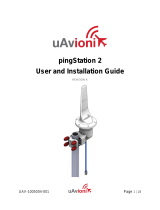 uAvionix pingStation 2 Installation guide
uAvionix pingStation 2 Installation guide
-
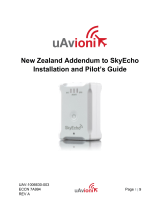 uAvionix SkyEcho Installation guide
uAvionix SkyEcho Installation guide
-
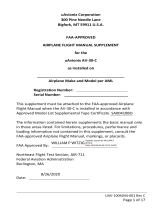 uAvionix AV-30-C STC Owner's manual
uAvionix AV-30-C STC Owner's manual
-
 uAvionix tailBeaconX User guide
uAvionix tailBeaconX User guide
-
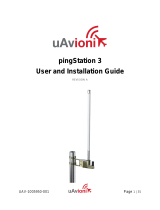 uAvionix pingStation 3 Installation guide
uAvionix pingStation 3 Installation guide
-
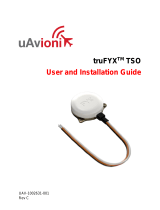 uAvionix truFYX Owner's manual
uAvionix truFYX Owner's manual
-
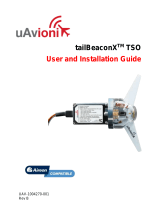 uAvionix tailBeaconX Installation guide
uAvionix tailBeaconX Installation guide
-
 uAvionix ping20Si Quick start guide
uAvionix ping20Si Quick start guide
-
 uAvionix ping20Si Quick start guide
uAvionix ping20Si Quick start guide
-
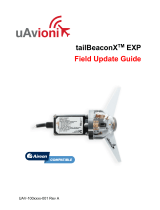 uAvionix tailBeaconX User guide
uAvionix tailBeaconX User guide
Other documents
-
AIRIS NAVIGATOR 4.3 User manual
-
Intel FALCON 8+ User manual
-
RACOM Ray2 User manual
-
KIA niro eco electric 2020 Owner's manual
-
Alcatel one touch club User manual
-
Parrot ANAFI Ai 4G Robotic UAV User manual
-
Case Logic EKS-103 Datasheet
-
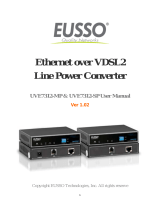 Eusso UVE7312-MP User manual
Eusso UVE7312-MP User manual
-
LevelOne VDS-0202 BNC User manual
-
LevelOne VDS-0120 User manual





































